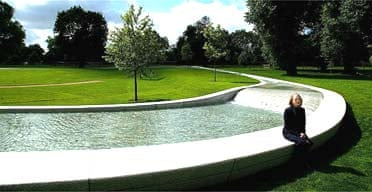Roger the mulch man stops near the Peter Pan statue in Hyde Park to give me a lift to the newly completed Diana, Princess of Wales memorial fountain.
We have a nice drive at walking pace through the early morning park alongside the Serpentine lake; coots hooting, skateboarders rumbling and riders trotting by, children splashing about at the water's edge, and the back of our forest green Royal Parks Transit piled high with mulch. Not any old mulch, says Roger, but 10-year-old mulch. Right royal mulch, I suggest. Which, as it happens, it was.
Transit, gardener, fertiliser and journalist pull up beside the fountain which the Queen is due to open next Tuesday with much of the royal family, including the Prince of Wales, on parade. The stonework is in place, water flows and the landscaping is being tidied up with mulch and turf.
The fountain, a ring of bright water, is very nice. From a distance it looks a little like a giant Scalextric or miniature racing circuit, or a Disney-style water-splash ride for children, and, close up, it resembles a finely crafted drainage outlet from an Edwardian dam or waterworks; examples of these in the Elam Valley or at Lake Vyrnwy prove that hydraulic design can be very beautiful.
The memorial is overlooked by Sir Basil Spence's priapic Knightsbridge Barracks with its horses and cavalrymen; the princess had a soft spot for men in uniform, notably her riding instructor James Hewitt, a guards officer.
Is it by chance or design that Kathryn Gustafson and Neil Porter appear to have designed a near perfect metaphor for the life of Diana? Water ebbs, flows, gushes and chuckles round and around this prescribed oval course of beautifully cut granite slabs, before filtering out to a wider and more receptive world in the guise of the Serpentine with the tall and masculine buildings on its skyline receding into the summer haze.
The cycle of a princess's life, you see, with all its ups and its downs, and their ultimate draining away.
Was it not Shaw who said: "Love is just like a merry-go-round with all the fun of a fair/One day I'm feeling down on the ground, then I'm up in the air." Sandie Shaw, that is, not George Bernard.
The Diana fountain is ringed around with a shore not of sand, but of hard, cool, unmoveable granite. Not any stone this, but 545 slabs of Delank granite, cut with by-appointment perfection from quarries in the heart of Duchy of Cornwall. In death, as in life, the effusive Diana is surrounded by the stiffer world of her former husband.
The cast of characters involved in the evolution of the fountain appear to be equally contrary.
Journalists' questions at a press conference in Hyde Park yesterday were fielded by, among others, Rosa Monckton, chairwoman of the Memorial Fountain Committee, a lady of few, gunshot-like words, stiff in a padded-shouldered lilac suit, expensive suntan, big hair and even bigger jewellery.
She sat by the spectral, white-faced, black-clad figure of Gustafson, the quietly spoken and ruminative American landscape architect.
The memorial fountain is like this: a surprising, yet ultimately gentle drawing together of unlikely family, friends and supporters of the late princess, and design professionals.
It is a very English compromise, one that will neither frighten the horses plodding around Hyde Park, nor offend any of the millions of people who will pass this way to dip a toe, as it were, into Diana's memory.
Is there a sense of peace and reconciliation here in Hyde Park today? I do not know; and who knows what Diana would have made of such a gesture. I wonder, though, if she knew the story of her classical namesake, the goddess of hunting who, when cornered in her bath - an ornamental pond or pool in renaissance paintings - turned her would-be suitor, the prying Actaeon, into a stag torn to pieces by his own hounds. Hyde Park, obtained for the crown from the church by Henry VIII, was for many years a royal hunting ground. Its spiritual patroness was Diana.
There is nothing so nasty here in the Hyde Park woodlands today. When the press and royals have done their bit, and the mulch around it has settled, the fountain will be left for future generations of children and dogs to splash about in in the spirit of ageless Peter Pan whose statue stands close by; and, very nice that will be, too.
· Jonathan Glancey is the Guardian's architecture correspondent
